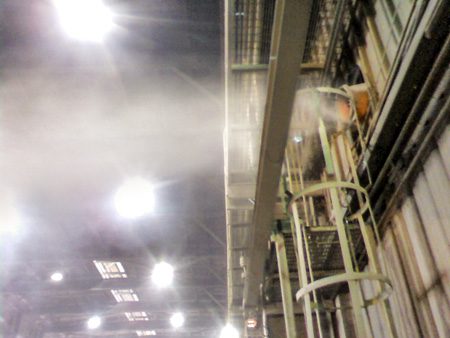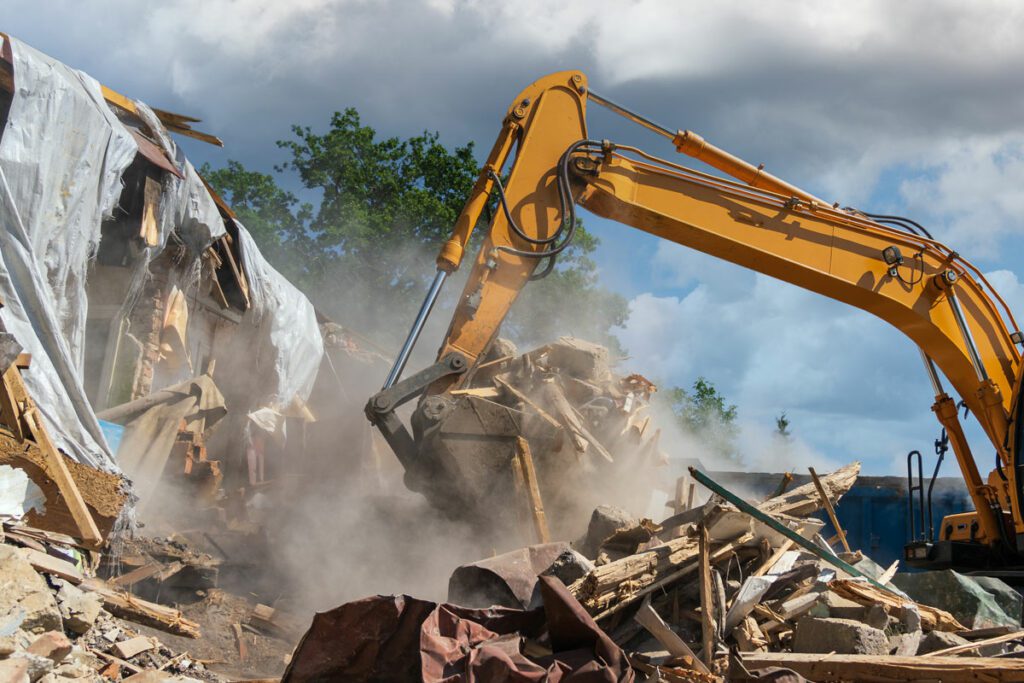“We needed something that could control the dust quickly as it was generated at ground level.”
- John Andric
Senior Engineer
One of the largest mini-mill steel producers and recyclers in North America is putting a “wet blanket” on slag dust from ladle and tundish dumping, improving safety and cleanliness, while preventing dust migration.
Gerdau Ameristeel in Cambridge, Ontario, Canada, uses a specially-designed dust suppression mist system, reducing potential hazards and improving visibility around the dumping pit and in the nearby service area.
The versatile dust control equipment can be operated by remote control from the overhead crane, from a front loader or by the ground-level control panel.
The Cambridge facility has the capacity to produce 300,000 standard tons annually of low to medium carbon steel bars, primarily from feedstocks of recycled materials.
“At the end of a casting sequence, several tons of slag can be left over that must be purged,” said Senior Engineer John Andric. “When ladles and tundishes are dumped, the falling slag has the potential to create large quantities of dust.”


Andric described the conditions that factored into the company’s dust management decision.
“Although it’s indoors, the melt shop has a draft from one end to the other,” he said. “We did preliminary engineering for a bag house dust collector and overhead canopy, but the project estimate was well over a million dollars and there were doubts as to how successful it would be.
“The concern was how effectively the canopy over the cranes would prevent migration,” Andric said. “We needed something that could control the dust quickly as it was generated, at ground level.”
“It does just what it was designed to do, delivering the mist over a wide coverage area.”
- John Andric
Senior Engineer
After seeing a DustBoss unit in action in another steelmaking facility, Gerdau Cambridge opted to specify a DB-30 for the slag dump area. The DB-30 dust control machine has long been known for performance that belies its smaller size, capturing dust particles more effectively than many of the larger competing machines.
Mounted on a movable carriage, the unit has a 7.5 HP (5.6 Kw) motor that generates 9,200 CFM (260 CMM) of air flow. The ducted fan design has an adjustable throw angle from 0-50° elevation and the standard unit oscillates up to 70°.
When equipped with the new 359° oscillation option, the DB-30 can cover more than 30,000 square feet of area (2,787 square meters) — nearly 3/4 of an acre — using just a standard 5/8" garden hose.
The Science of Slag Dust
There are typically three different opportunities for fugitive slag particle emissions to emerge during steel processing. The first is from the initial fall of material, and is usually of short duration.
“We did preliminary engineering for a bag house dust collector and overhead canopy, but the project estimate was well over a million dollars and there were doubts as to how successful it would be."
- John Andric
Senior Engineer
The second occurs during subsequent tempering and cooling operations, when vapor from the cooling water rises and carries particulates into the air. Dust can also be released any time a particle’s terminal settling velocity (from gravity) is lower than the thermal updraft velocity (from heat), which causes it to rise and potentially migrate.
Unfortunately, slag dust is made up of a number of different-sized particles, some of which are extremely small and lightweight, therefore mobile. DustBoss equipment has been extensively tested at a number of slag processing sites, with various modifications and configurations evaluated in a range of combinations to gauge their effectiveness. Some units have been mounted on trailers and flatbed trucks to deliver virtually unlimited mobility, and others have been permanently mounted in elevated locations.
One of the keys to the equipment’s success has been the ability to automate operation, allowing slag processors to control on/off cycles, direction, oscillation arc and other features from a remote location or via hand-held wireless control.
Fully-integrated systems can be operated entirely by remote control whenever a slag dump is underway, allowing a single staff member to selectively adjust as many as a hundred of the high-output misting units without having to physically visit any of them.
Andric says he’s pleased with the results from the DustBoss.
“It does just what it was designed to do, delivering the mist over a wide coverage area,” he said. “The dust particles and water droplets are brought into collision with each other, which prevents the dust from drifting through the shop.”
CUSTOMER
Gerdau Ameristeel
LOCATION
Cambridge, Ontario
CHALLENGE
Find a way to effectively control slag dust quickly as it’s generated at the end of a casting sequence when ladles and tundishes are dumped, thereby reducing potential hazards and improving visibility around the dumping pit and nearby service area.
SOLUTION
The DustBoss® 30 (DB-30), a portable oscillating ducted fan design that delivers a range of more than 100 feet from its 7.5 HP motor. When equipped with optional 359º oscillation the unit can blanket over 30,000 square feet (nearly 2,800 square meters) from a single position with a fine mist of water droplets that are atomized to the optimum size for particle attraction and dust control.
RESULTS
Gerdau Ameristeel is pleased with the results from the DustBoss. “It does just what it was designed to do,” said a spokesman, “delivering the mist over a wide coverage area, which prevents the dust from drifting through the shop.”
GERDAU AMERISTEEL
is the second largest mini-mill steel producer in North America, with annual manufacturing capacity of approximately 10 million metric tons of mill finished steel products. Through its vertically integrated network of mini-mills, scrap recycling facilities and downstream opeations, Gerdau Ameristeel serves customers throughout the United States and Canada. The company's products are generally sold to steel service centers, steel fabricators or directly to OEMs for use in a wide variety of industries. Gerdau Ameristeel is a wholly-owned subsidiary of Gerdau S.A., the leading producer of long steel in the Americas and one of the world’s largest suppliers of specialty long steel.
“We needed something that could control the dust quickly as it was generated at ground level.”
- John Andric
Senior Engineer
One of the largest mini-mill steel producers and recyclers in North America is putting a “wet blanket” on slag dust from ladle and tundish dumping, improving safety and cleanliness, while preventing dust migration.
Gerdau Ameristeel in Cambridge, Ontario, Canada, uses a specially-designed dust suppression mist system, reducing potential hazards and improving visibility around the dumping pit and in the nearby service area.
The versatile dust control equipment can be operated by remote control from the overhead crane, from a front loader or by the ground-level control panel.
The Cambridge facility has the capacity to produce 300,000 standard tons annually of low to medium carbon steel bars, primarily from feedstocks of recycled materials.
“At the end of a casting sequence, several tons of slag can be left over that must be purged,” said Senior Engineer John Andric. “When ladles and tundishes are dumped, the falling slag has the potential to create large quantities of dust.”


Andric described the conditions that factored into the company’s dust management decision.
“Although it’s indoors, the melt shop has a draft from one end to the other,” he said. “We did preliminary engineering for a bag house dust collector and overhead canopy, but the project estimate was well over a million dollars and there were doubts as to how successful it would be.
“The concern was how effectively the canopy over the cranes would prevent migration,” Andric said. “We needed something that could control the dust quickly as it was generated, at ground level.”
“It does just what it was designed to do, delivering the mist over a wide coverage area.”
- John Andric
Senior Engineer
After seeing a DustBoss unit in action in another steelmaking facility, Gerdau Cambridge opted to specify a DB-30 for the slag dump area. The DB-30 dust control machine has long been known for performance that belies its smaller size, capturing dust particles more effectively than many of the larger competing machines.
Mounted on a movable carriage, the unit has a 7.5 HP (5.6 Kw) motor that generates 9,200 CFM (260 CMM) of air flow. The ducted fan design has an adjustable throw angle from 0-50° elevation and the standard unit oscillates up to 70°.
When equipped with the new 359° oscillation option, the DB-30 can cover more than 30,000 square feet of area (2,787 square meters) — nearly 3/4 of an acre — using just a standard 5/8" garden hose.
The Science of Slag Dust
There are typically three different opportunities for fugitive slag particle emissions to emerge during steel processing. The first is from the initial fall of material, and is usually of short duration.
“We did preliminary engineering for a bag house dust collector and overhead canopy, but the project estimate was well over a million dollars and there were doubts as to how successful it would be."
- John Andric
Senior Engineer
The second occurs during subsequent tempering and cooling operations, when vapor from the cooling water rises and carries particulates into the air. Dust can also be released any time a particle’s terminal settling velocity (from gravity) is lower than the thermal updraft velocity (from heat), which causes it to rise and potentially migrate.
Unfortunately, slag dust is made up of a number of different-sized particles, some of which are extremely small and lightweight, therefore mobile. DustBoss equipment has been extensively tested at a number of slag processing sites, with various modifications and configurations evaluated in a range of combinations to gauge their effectiveness. Some units have been mounted on trailers and flatbed trucks to deliver virtually unlimited mobility, and others have been permanently mounted in elevated locations.
One of the keys to the equipment’s success has been the ability to automate operation, allowing slag processors to control on/off cycles, direction, oscillation arc and other features from a remote location or via hand-held wireless control.
Fully-integrated systems can be operated entirely by remote control whenever a slag dump is underway, allowing a single staff member to selectively adjust as many as a hundred of the high-output misting units without having to physically visit any of them.
Andric says he’s pleased with the results from the DustBoss.
“It does just what it was designed to do, delivering the mist over a wide coverage area,” he said. “The dust particles and water droplets are brought into collision with each other, which prevents the dust from drifting through the shop.”
Implement Dust Control at Your Jobsite!
Receive a FREE quote and talk to a dust control specialist today to stop fugitive dust!
Get A Quote
More on BossTek
Subscribe and Stay Up-to-Date!
Receive a monthly newsletter keeping you up-to-date on the latest in dust and odor control.
Subscribe





